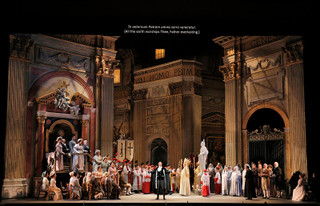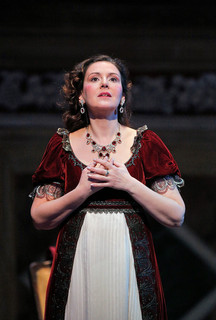|
Back
Classically Tailored Verismo San Diego
Civic Theater
02/13/2016 - & February 16, 19, 21, 2016
Giacomo Puccini: Tosca
Alexia Voulgaridou (Tosca), Gwyn Hughes Jones (Cavaradossi), Greer Grimsley (Scarpia), Kristopher Irmiter (Angelotti, Sciarrone), Joel Sorensen (Spoletta), Scott Sikon (Sacristan), Bridget Hogan (Shepherd Boy), Johnnie Bankens (Jailer)
Jeff Thayer (Concertmaster), Charles F. Prestinari (Chorus Master), Massimo Zanetti (Conductor)
Lesley Koenig (Stage Director), Andrew Horn (Set Designer), Andrew Marlay (Costume Designer), Gary Marder (Lighting Designer), Steven W. Bryant (Wig and Makeup Designer) 
(© Cory Weaver)
Despite a tumultuous two years, San Diego Opera (SDO) has redefined and transformed itself into a profitable, thrifty institution. David Bennett’s curtain announcement of fiscal optimism looked ahead by declaring the subsequent season (2016-2017) would add two smaller-scale works to its existing framework. While ambitions are great, SDO has always oriented itself with a modicum of conservative works, and this year SDO plays it safe by opening with Tosca. Even though this is the eighth time this old chestnut has been brought to the main stage, the overall élan is very satisfying with a few interesting twists and asterisks.
This year unveils SDO’s newly acquired production from Ft. Worth Opera with apropos fittings: predictable comfort. But what’s impressive in this Lesley Koenig direction is the element of finesse, refinement and tasteful values: Andrew Horn’s scenery is enveloped with richly muted regalia, particularly carrying over into costume design by Andrew Marlay that features a soft-spoken color palette. The traditionally authentic display in textures and fabrics is indicative everywhere, yet it is especially pronounced during Act I’s “Processional” where Vatican Guards, papal surplice reds and whites stand out alongside the worshippers bathed in Easter egg color dress. The added aesthetics of the aforementioned are extremely sensitized through Gary Marder’s intuitive lighting, providing Caravaggio-like chiaroscuro temperament.
The carryover of the physical accoutrement délicat swirls amongst debuting Alexia Voulgaridou and Gwyn Hughes Jones as Tosca and Cavaradossi, respectively. Scott Sikon’s Sacristan lightly humors as he ushers Hughes Jones into “Recondita armonia” which reveals an unflinching lirico spinto voice with a finely tuned brass lining. The delivery is sharp though never insanely dramatic. Early stage jitters could attribute to rigid projection, but his Cavaradossi fieriness catapults as the opera progresses. By the time “E lucevan le stelle” arrives, Gwyn Hughes Jones has found his pinnacle drive and passion.

(© Cory Weaver)
Greek native Alexia Voulgaridou has her own equally monumental evening. Her Tosca adds a genteel chemistry well balancing with Jones. Don’t let this petite soprano fool you, for her character development continues to nicely unravel in pitch and volume. On another note, the intensity with Scarpia appears to expunge her ability to get a decent handle around “Vissi d’arte.” Massimo Zanetti strongly pauses in order for Voulgaridou to establish posture and control. Though the singing is firmly spot-on, her sustenance is shortened. On balance, she’s a finely executed Tosca, retaining well-placed volumetric control and convincing verismo acting.
Returning favorite Greer Grimsley portrays the evil Scarpia with confidence and understated lecherousness. Last seen in 2009, Mr. Grimsley appears to have matured, and he is better positioned this time around. His vocal strength is powerful enough to match Puccini’s fortissimo accentuations during the closing “Nel tuo cuor s’annida Scarpia” in Act I.

(© Cory Weaver)
Charles F. Prestinari has an angelic arena of youthful voices, but occasional hiccups ignite during offstage singing: choral blending drowns out the Scarpia/Tosca drama in Act II while Bridget Hogan’s shepherd’s boy song opening Act III is wan...a pity, for her tone is in keeping with the early dawn inside the Castello Sant’Angelo.
Supporting roles also have important foundational value. Joel Sorensen, frequently seen in SDO productions, handles Spoletta with subservient display while Kristopher Irmiter’s duo role as Angelotti/Sciarrone gets more press when he opens the opera as the restrained and emaciated prisoner; the voice is virile and substantial.
Massimo Zanetti has a great grasp on the tempo of Tosca. The Orchestra deftly maneuvers through Puccini’s capricious score to give the opera an additional thoughtful injection.
During curtain call, Lesley Koenig hesitantly moves forward to take a bow. This shy attitude speaks volumes, deciphering overall demeanor and general appeal of this production. Giacomo Puccini’s opera is riddled with drama from beginning to end, but there’s an unspoken degree of nuanced elegance and civility which should not go unrecognized. San Diego Opera has captured it all with superb craftsmanship.
Christie Grimstad
|